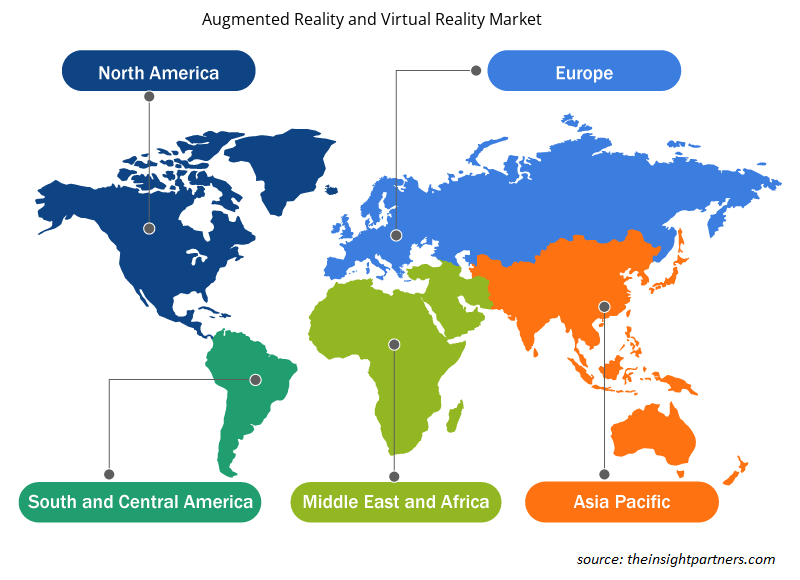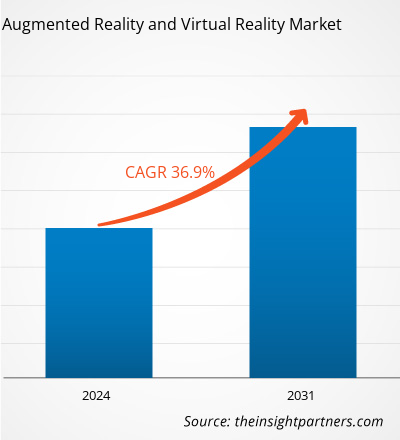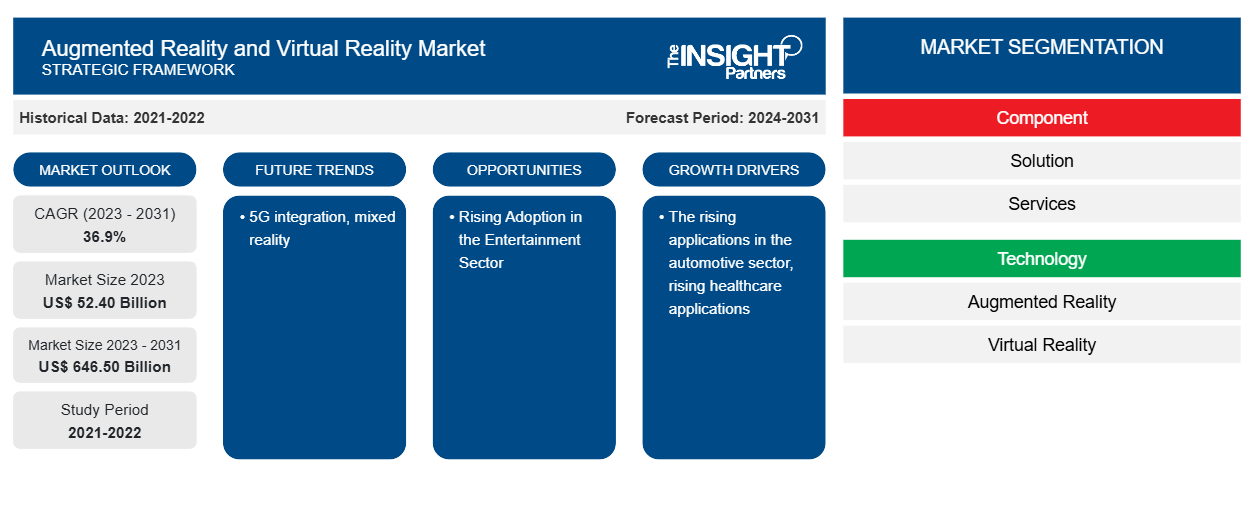Si prevede che la dimensione del mercato della realtà aumentata e della realtà virtuale raggiungerà i 646,50 miliardi di dollari entro il 2031, rispetto ai 52,40 miliardi di dollari del 2023. Si prevede che il mercato registrerà un CAGR del 36,9% nel periodo 2023-2031. È probabile che l'integrazione 5G e la realtà mista rimangano tendenze chiave nel mercato.
Analisi di mercato della realtà aumentata e della realtà virtuale
La tecnologia AR e VR offre numerose opportunità uniche sia per le imprese nuove che per quelle consolidate e per il commercio. La tecnologia AR consente alle persone di numerose professioni di vedere la grafica generata al computer nel loro campo visivo. Entrambe le tecnologie sono ampiamente utilizzate in diversi settori, tra cui sanità, media, gas e petrolio, turismo, istruzione, giochi, intrattenimento, esercito, marketing, e-commerce e vendita al dettaglio.
Panoramica del mercato della realtà aumentata e della realtà virtuale
Il settore AR e VR globale sta vivendo una rapida espansione a causa della crescente domanda di dispositivi mobili e degli investimenti in R&S. La tecnologia AR/VR ha una scarsa domanda e adozione rispetto ad altri dispositivi di consumo a causa del suo costo elevato e dell'impatto visivo. Le principali multinazionali tecnologiche stanno investendo nella ricerca e nello sviluppo VR/AR per far progredire la tecnologia.
Personalizza questo report in base alle tue esigenze
Riceverai la personalizzazione gratuita di qualsiasi report, comprese parti di questo report, o analisi a livello nazionale, pacchetto dati Excel, oltre a usufruire di grandi offerte e sconti per start-up e università
-
Scopri le principali tendenze di mercato in questo rapporto.Questo campione GRATUITO includerà analisi di dati che spaziano dalle tendenze di mercato alle stime e alle previsioni.
Driver e opportunità di mercato della realtà aumentata e della realtà virtuale
Le crescenti applicazioni nel settore automobilistico favoriscono il mercato
AR/VR nel settore automobilistico sta diventando sempre più uno standard grazie alle numerose applicazioni e ai vantaggi che offre. Semplifica e migliora l'acquisto del veicolo e l'esperienza di guida per tutte le parti interessate. Il settore automobilistico sta adottando aggressivamente AR/VR per migliorare le esperienze di guida e di vacanza. Infatti, tra tutti i principali settori, il settore automobilistico è quello che ha investito di più nelle tecnologie AR e VR. Alcuni pesi massimi del settore, come Porsche, Chrysler, Hyundai, Mitsubishi e Tesla, hanno già integrato le due tecnologie in varie fasi di produzione, marketing e vendita dei veicoli. Ciò sta guidando la domanda nel mercato della realtà aumentata e della realtà virtuale.
Crescente adozione nel settore dell'intrattenimento
Il settore dell'intrattenimento in realtà virtuale ha avuto un impatto significativo sul modo in cui i consumatori consumano i media, causando un cambiamento di paradigma in tutto, dai videogiochi ai film, spettacoli dal vivo ed esperienze nei parchi di divertimento. La tecnologia VR/AR (realtà virtuale/realtà aumentata) sta già iniziando ad avere un impatto sulla trasmissione e lo streaming dei media. La trasmissione e lo streaming VR/AR possono offrire agli spettatori un'esperienza completamente immersiva, consentendo loro di interagire con il materiale in modi nuovi e intriganti. Questa tecnologia può essere utilizzata per produrre esperienze accattivanti come film a 360 gradi, copertura sportiva interattiva, eventi musicali in realtà virtuale e molto altro.
Analisi della segmentazione del rapporto di mercato sulla realtà aumentata e sulla realtà virtuale
I segmenti chiave che hanno contribuito alla derivazione dell'analisi di mercato della realtà aumentata e della realtà virtuale sono la tecnologia, i componenti e l'industria dell'utente finale.
- In base alla tecnologia, il mercato della realtà aumentata e della realtà virtuale è diviso in realtà aumentata e realtà virtuale. Il segmento della realtà aumentata ha detenuto una quota di mercato maggiore nel 2023.
- In base ai componenti, il mercato è segmentato in componenti semiconduttori diretti, sensori e altri.
- In base al settore dell'utente finale, il mercato è segmentato in intrattenimento, istruzione, industria, medicina, immobiliare e architettura, vendita al dettaglio, aerospaziale e difesa e altri.
Analisi della quota di mercato della realtà aumentata e della realtà virtuale per area geografica
L'ambito geografico del rapporto sul mercato della realtà aumentata e della realtà virtuale è suddiviso principalmente in cinque regioni: Nord America, Asia Pacifico, Europa, Medio Oriente e Africa, e Sud e Centro America.
Il Nord America ha dominato la quota di mercato della realtà aumentata e della realtà virtuale nel 2023. La regione ha paesi come gli Stati Uniti e il Canada, che sono tecnologicamente avanzati. Il panorama delle startup negli Stati Uniti è in continua evoluzione, con attori emergenti che ottengono innovazioni nelle tecnologie AR e VR all'avanguardia.
Approfondimenti regionali sul mercato della realtà aumentata e della realtà virtuale
Le tendenze regionali e i fattori che influenzano il mercato della realtà aumentata e della realtà virtuale durante il periodo di previsione sono stati ampiamente spiegati dagli analisti di Insight Partners. Questa sezione discute anche i segmenti e la geografia del mercato della realtà aumentata e della realtà virtuale in Nord America, Europa, Asia Pacifico, Medio Oriente e Africa e America meridionale e centrale.

- Ottieni i dati specifici regionali per il mercato della realtà aumentata e della realtà virtuale
Ambito del rapporto di mercato sulla realtà aumentata e sulla realtà virtuale
| Attributo del report | Dettagli |
|---|---|
| Dimensioni del mercato nel 2023 | 52,40 miliardi di dollari USA |
| Dimensioni del mercato entro il 2031 | 646,50 miliardi di dollari USA |
| CAGR globale (2023-2031) | 36,9% |
| Dati storici | 2021-2022 |
| Periodo di previsione | 2024-2031 |
| Segmenti coperti |
Per componente
|
| Regioni e Paesi coperti |
America del Nord
|
| Leader di mercato e profili aziendali chiave |
|
Densità dei player del mercato della realtà aumentata e della realtà virtuale: comprendere il suo impatto sulle dinamiche aziendali
Il mercato della realtà aumentata e della realtà virtuale sta crescendo rapidamente, spinto dalla crescente domanda degli utenti finali dovuta a fattori quali l'evoluzione delle preferenze dei consumatori, i progressi tecnologici e una maggiore consapevolezza dei vantaggi del prodotto. Con l'aumento della domanda, le aziende stanno ampliando le loro offerte, innovando per soddisfare le esigenze dei consumatori e capitalizzando sulle tendenze emergenti, il che alimenta ulteriormente la crescita del mercato.
La densità degli operatori di mercato si riferisce alla distribuzione di aziende o società che operano in un particolare mercato o settore. Indica quanti concorrenti (operatori di mercato) sono presenti in un dato spazio di mercato in relazione alle sue dimensioni o al valore di mercato totale.
Le principali aziende che operano nel mercato della Realtà Aumentata e della Realtà Virtuale sono:
- Sguardo immersivo
- Società a responsabilità limitata Google LLC
- Realtà EON
- Società Vuzix
- Gruppo Blippar Limited (Layar BV)
- Azienda
Disclaimer : le aziende elencate sopra non sono classificate secondo un ordine particolare.

- Ottieni una panoramica dei principali attori del mercato della realtà aumentata e della realtà virtuale
Notizie e sviluppi recenti del mercato della realtà aumentata e della realtà virtuale
Il mercato della realtà aumentata e della realtà virtuale viene valutato raccogliendo dati qualitativi e quantitativi dopo la ricerca primaria e secondaria, che include importanti pubblicazioni aziendali, dati associativi e database. Di seguito sono elencati alcuni degli sviluppi nel mercato della realtà aumentata e della realtà virtuale:
- EON Reality annuncia con orgoglio il lancio del primo Spatial AI Center nelle Isole Marshall. Questa iniziativa fondamentale è destinata a trasformare l'approccio delle isole all'istruzione, all'assistenza sanitaria e alla resilienza climatica, implementando tecnologie immersive per sperimentare esperienze di apprendimento avanzate e sviluppo sostenibile. (Fonte: EON Reality, comunicato stampa, aprile 2024)
- Vuzix® Corporation (NASDAQ: VUZI) ha annunciato di aver ricevuto nuovi ordini aggiuntivi da due aziende aerospaziali e della difesa per sviluppare ulteriormente e fornire soluzioni di visualizzazione basate su guida d'onda nel 2024. (Fonte: Vuzix Corporation, comunicato stampa, aprile 2024)
Copertura e risultati del rapporto di mercato sulla realtà aumentata e sulla realtà virtuale
Il rapporto "Dimensioni e previsioni del mercato della realtà aumentata e della realtà virtuale (2021-2031)" fornisce un'analisi dettagliata del mercato che copre le seguenti aree:
- Dimensioni e previsioni del mercato della realtà aumentata e della realtà virtuale a livello globale, regionale e nazionale per tutti i segmenti di mercato chiave coperti dall'ambito
- Tendenze del mercato della realtà aumentata e della realtà virtuale, nonché dinamiche di mercato quali driver, vincoli e opportunità chiave
- Analisi dettagliata delle cinque forze PEST/Porter e SWOT
- Analisi di mercato della realtà aumentata e della realtà virtuale che copre le principali tendenze di mercato, il quadro globale e regionale, i principali attori, le normative e i recenti sviluppi del mercato
- Analisi del panorama industriale e della concorrenza che copre la concentrazione del mercato, l'analisi della mappa di calore, i principali attori e gli sviluppi recenti per il mercato della realtà aumentata e della realtà virtuale
- Profili aziendali dettagliati
- Analisi storica (2 anni), anno base, previsione (7 anni) con CAGR
- Analisi PEST e SWOT
- Valore/volume delle dimensioni del mercato - Globale, Regionale, Nazionale
- Industria e panorama competitivo
- Set di dati Excel
Report recenti
Testimonianze
Motivo dell'acquisto
- Processo decisionale informato
- Comprensione delle dinamiche di mercato
- Analisi competitiva
- Analisi dei clienti
- Previsioni di mercato
- Mitigazione del rischio
- Pianificazione strategica
- Giustificazione degli investimenti
- Identificazione dei mercati emergenti
- Miglioramento delle strategie di marketing
- Aumento dell'efficienza operativa
- Allineamento alle tendenze normative























 Ottieni un campione gratuito per - Mercato della realtà aumentata e della realtà virtuale
Ottieni un campione gratuito per - Mercato della realtà aumentata e della realtà virtuale